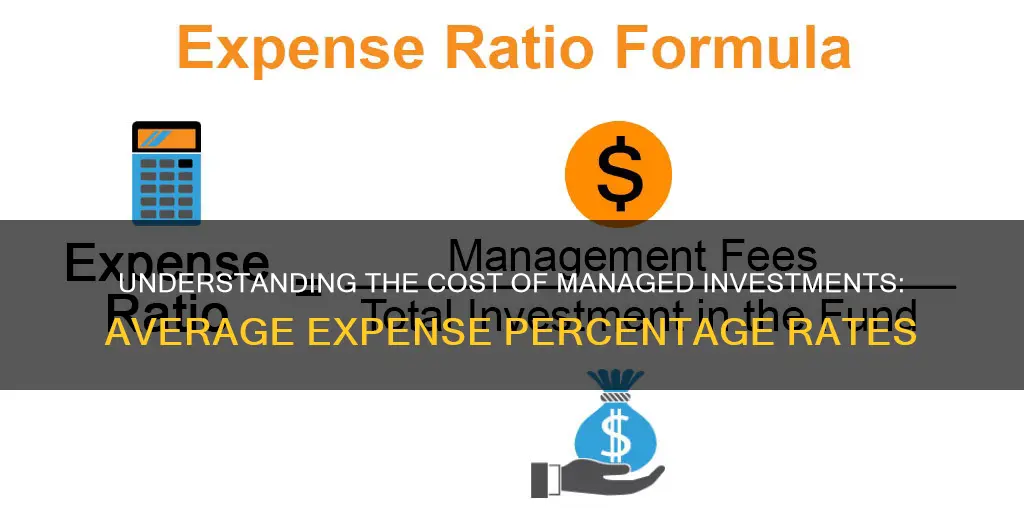
When it comes to investing, one of the most important factors to consider is the expense ratio. This is the annual fee that investors pay for the management of their fund, and it includes all administrative, marketing and management fees. The expense ratio is calculated by dividing a fund's operating expenses by its net assets, and it is usually represented as a percentage. For example, an expense ratio of 0.2% means that for every $1,000 you invest in a fund, you'll pay $2 annually in operating expenses.
The expense ratio is important because it lets an investor know how much they are paying to invest in a specific fund and how much their returns will be reduced. A higher expense ratio can eat away at your investment returns, so it's crucial to compare mutual fund schemes and consider if the higher expense ratio justifies the fund's returns.
Over time, a low expense ratio can help reduce investment costs and boost returns. For example, consider two mutual funds, both offering annual returns of 12%. If one fund has an expense ratio of 0.5% while the other has a ratio of 1.2%, the first fund has a better potential for higher returns simply because of its lower expense ratio.
A good expense ratio depends on several factors, including the type of fund, the fund's investment strategy, and the level of trading activity. Typically, for actively managed funds, a good expense ratio falls between 0.5% and 0.75%. Ratios above 1.5% are generally considered high.
When choosing a mutual fund, investors should carefully weigh the cost against the benefits offered, considering their specific financial goals and risk tolerance.
| Characteristics | Values |
|---|---|
| What is an expense ratio? | The fee you pay for funds, usually a mutual fund or an exchange-traded fund (ETF). |
| How is it calculated? | Total fund expenses / Total fund assets under management = Expense ratio |
| How is it charged? | Expense ratios are usually expressed as a percentage of your investment in a fund. |
| Average expense ratios | According to Morningstar, the average expense ratios for open-end funds have nearly shrunk in half from 0.87% in 1999 to 0.45% in 2019. |
| Good expense ratios | For an actively managed fund, a good expense ratio ranges between 0.40% for a domestic bond fund to around 1.0% for an international stock fund. For passive funds, a good expense ratio is between 0.05% to 0.20%. |
| Impact on investment returns | A higher expense ratio can eat away at your investment returns. |
What You'll Learn

What is an expense ratio?
An expense ratio is a fee that investors pay for the management of a fund, such as a mutual fund or an exchange-traded fund (ETF). It is calculated by dividing a fund's operating expenses by its net assets, and it is usually expressed as a percentage of the fund's average net assets. For example, an expense ratio of 0.2% means that for every $1,000 invested in a fund, the investor pays $2 per year in operating expenses. These expenses are taken out of the fund's total value over time, reducing the investor's returns.
Expense ratios cover the costs of portfolio management, administration, marketing, and distribution, among other expenses. They are important because they allow investors to know how much they are paying to invest in a specific fund and how much their returns will be reduced. A high expense ratio can significantly impact an investor's returns, so it is generally recommended to seek out funds with lower expense ratios.
The expense ratios of funds vary depending on whether they are actively or passively managed. Actively managed funds tend to have higher expense ratios because they involve more research and analysis, while passively managed funds, such as index funds, have lower expense ratios since they aim to match the performance of a specific market index.
When evaluating expense ratios, investors typically consider two main factors: whether the fund is actively or passively managed, and the size of the fund. A good expense ratio for an actively managed fund is generally considered to be between 0.5% and 0.75%, while a ratio above 1.5% is typically considered high. For passively managed funds, the average expense ratio is about 0.12%.
In recent years, competition among investment funds has led to a decline in expense ratios overall. This is particularly true for passively managed exchange-traded funds, which have become increasingly popular due to their low fees.
How Interest Rates Affect Savings and Investments
You may want to see also

How is an expense ratio calculated?
The expense ratio of a fund is calculated by dividing the total annual operating expenses incurred by a fund by the average value of the total assets managed. This is usually calculated by the fund itself and is rarely needed to be calculated by investors, as it is an important metric and is almost always found on a fund's website. However, if you need to calculate it, the formula is as follows:
Expense Ratio = Total Annual Operating Expenses ÷ Average Fund Assets
The total annual operating expenses include management fees, employee salaries, administrative expenses, customer support, third-party fees, marketing and distribution fees, and overhead costs. The average fund assets refer to the net assets of the fund.
For example, if a mutual fund incurred $2 million in operating costs for a year and managed $200 million in assets, the expense ratio would be 1.0%. This means that for every $10,000 invested in the fund, an investor would pay $100 in fees annually.
It is important to note that the expense ratio is usually expressed as a percentage and that a lower expense ratio is generally preferable as it indicates a more cost-effective investment option.
Investment Managers: New Products, Alpha Generation?
You may want to see also

How do expense ratios affect returns?
While expense ratios are essential for covering the costs of running a fund, they directly reduce an investor's returns. This reduction is more pronounced over longer periods, as fees compound and eat into a larger proportion of the investment.
For example, a fund with an average annual return of 10% and an expense ratio of 0.5% will yield a net annual return of 9.5%. Over 20 years, an initial investment of $10,000 in a fund with a 2.5% expense ratio would be worth $51,524, while the same investment in a fund with a 0.5% expense ratio would be worth $64,122, This represents a 24% improvement in the value of the investment.
The impact of expense ratios is also significant when investing with annual contributions, such as a 401(k) plan. Assuming an average annual rate of return of 7% and annual contributions of $10,000 over 30 years, a plan invested in funds with an average expense ratio of 0.75% would be worth $853,968. However, if the plan was invested in funds with an average expense ratio of 0.10%, it would be worth $962,108, a difference of $108,140.
When considering the impact of expense ratios on returns, it is important to compare funds within the same sector, as expense ratios can vary significantly between different types of funds. Actively managed funds tend to have higher expense ratios than passively managed funds due to the higher operational costs associated with active management. International funds, for instance, often require staffing in multiple countries, leading to higher research expenses and payroll costs.
To make informed investment decisions, it is crucial to consider not only the potential returns but also the associated costs, including expense ratios, as these can significantly affect the overall profitability of an investment.
Building an Investment Portfolio: A Comprehensive Guide
You may want to see also

What is a good expense ratio?
When it comes to investing in mutual funds or exchange-traded funds (ETFs), the expense ratio is one of the most important factors to consider. An expense ratio is essentially the fee investors pay for the management of a fund, which includes all administrative, marketing, and management costs. It is calculated by dividing a mutual fund's operating expenses by the average total dollar value of all the assets in the fund.
Expense ratios are typically represented as a percentage. For example, an expense ratio of 0.2% means that for every $1,000 invested in a fund, the investor pays $2 annually in operating expenses. These fees are taken out of the investor's returns over time, so they cannot be avoided.
A good expense ratio depends on various factors, such as whether the fund is actively or passively managed, and the type of fund. For an actively managed fund, a good expense ratio typically ranges between 0.5% and 0.75%. Actively managed funds tend to have higher expense ratios because they require more expertise and active decision-making. Mutual funds that invest in large companies should aim for an expense ratio of no more than 1%, while funds focusing on small companies or international stocks should aim for less than 1.25%.
On the other hand, passively managed funds, such as index funds, typically have lower expense ratios because they aim to replicate the performance of a specific market index rather than beat it. Exchange-traded funds (ETFs) are usually passively managed, and their expense ratios tend to be lower than those of mutual funds. The average expense ratio for passive funds is about 0.12%.
When considering what constitutes a good expense ratio, it's important to compare it to the industry average and other similar funds. The simple average of all funds can be compared to see how it ranks overall, while the asset-weighted average of all funds indicates whether the investor is getting a better price than most other investors.
In general, investors should aim for a fund with an expense ratio below the asset-weighted average, as lower costs are preferable. It's also worth noting that expense ratios have been declining over the years due to the increasing popularity of cheaper passive funds.
To find funds with low expense ratios, investors can use screeners provided by brokers or financial websites. It's recommended to avoid funds with expense ratios higher than 1%, as there are many ETFs with much lower ratios. Prioritizing funds with competitive and stable expense ratios can help investors avoid paying high fees.
Effective Yield: Understanding Your Investment Portfolio's Performance
You may want to see also

How to find funds with low expense ratios?
When it comes to investing, expense ratios are an important consideration as they can eat away at your investment earnings. An expense ratio is essentially a fee that investors pay for the management of a fund, which includes all administrative, marketing and management fees. It is calculated as the fund's net operating expenses divided by the fund's net assets and is typically represented as a percentage.
As a general rule, a good expense ratio is considered to be around 0.5% to 0.75% for an actively managed portfolio, while an expense ratio greater than 1.5% is typically considered high. For passive funds, the average expense ratio is about 0.12%.
- Passively managed index funds: Almost all Exchange-Traded Funds (ETFs) are passively managed index funds, meaning they aim to track the performance of a specific index. As they require less portfolio management and active trading, they tend to have lower expense ratios compared to the average mutual fund.
- Index mutual funds: Similar to ETFs, index mutual funds are passively managed and are often even cheaper. However, mutual funds may come with certain disadvantages relative to ETFs.
- Funds based on major indexes: Funds based on a major index, such as the S&P 500, tend to have among the lowest expense ratios.
- Screening tools: Some brokers, like Charles Schwab and Fidelity Investments, offer screening tools that allow you to filter and compare funds based on various criteria, including expense ratios.
- Financial resources: Utilise financial news websites such as Google Finance and Yahoo! Finance, or news journals like Investor's Business Daily and The Wall Street Journal, to find information on fund expense ratios.
- Fund prospectuses: If you are a shareholder, you can review the fund prospectus, which is typically sent out annually and includes information on the expense ratio. You can also access the prospectus on the fund company's website.
- Low-cost ETFs: Bankrate has identified some top low-cost ETFs for major segments of the market.
By using these methods and considering the expense ratios and fund types, you can make more informed investment decisions and potentially save a significant amount of money over time.
Understanding Investment Management: Strategies for Success
You may want to see also
Frequently asked questions
An expense ratio is a fee charged by investment companies to investors who own mutual funds and exchange-traded funds (ETFs). It is calculated by dividing a fund's operating expenses by its net assets. The expense ratio is important because it lets an investor know how much they are paying to invest in a specific fund and how much their returns will be reduced.
A good expense ratio depends on several factors, including whether the fund is actively or passively managed. For actively managed funds, a good expense ratio typically falls between 0.5% and 0.75%. Ratios above 1.5% are generally considered high. For passive funds, a good expense ratio is usually around 0.12%.
There are a few ways to find funds with low expense ratios. One way is to consider adopting a passive approach to investing, as passively managed funds tend to have lower expense ratios than actively managed funds. Another way is to invest in index mutual funds or ETFs, as these funds aim to replicate the performance of a specific index and therefore have lower fees. Additionally, you can compare the expense ratios of different funds within the same category to find the lowest-cost options.







